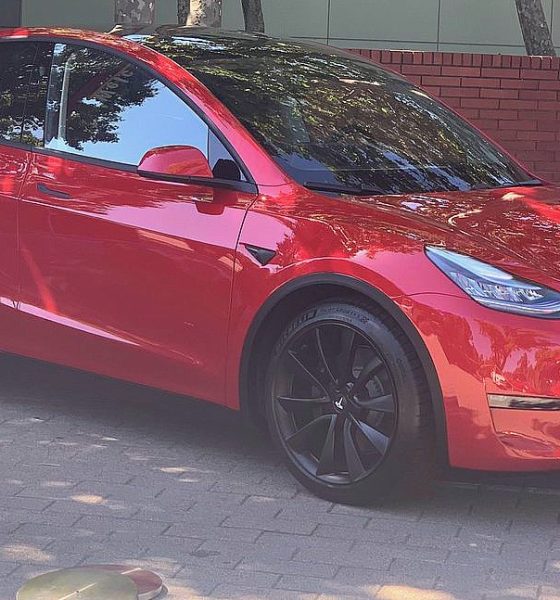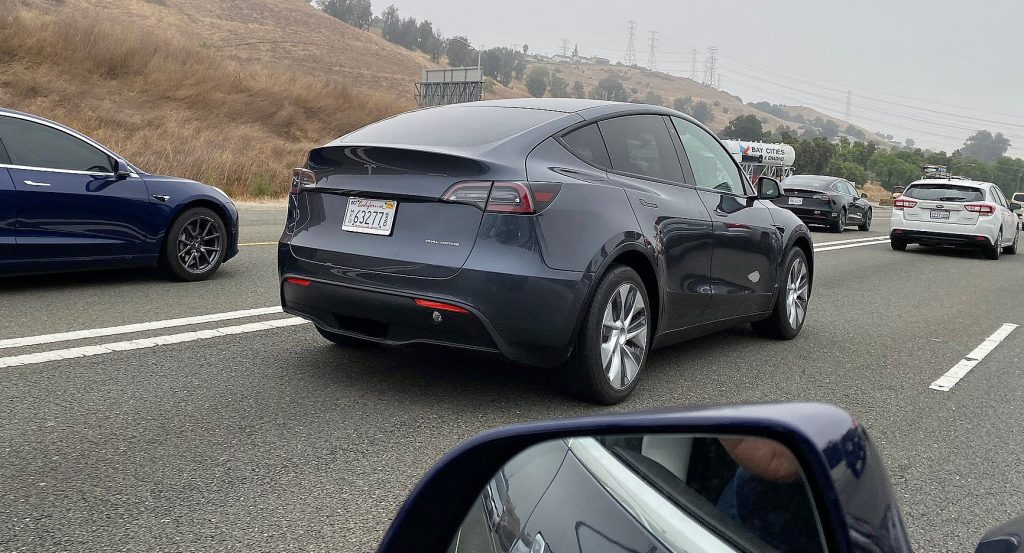

News
Tesla’s more experienced rivals are strangely making way for the Model Y
Something strange is happening in the crossover EV segment. Despite beating the Tesla Model Y to the market, European all-electric SUVs appear to be making way for the Silicon Valley-made disruptor. This shows that while Tesla may be entering the lucrative crossover segment later than its rivals, it will be doing so with a vehicle that does not seem to have a lot of willing challengers.
It should be noted that the Model Y is designed to compete in the auto industry’s most cutthroat segment. Dominated by iconic, hyper-reliable vehicles like the Honda CR-V and the Toyota RAV-4, the crossover market is as lucrative as it is competitive. In a way, crossovers are usually bang-for-the-buck cars: larger and more spacious than sedans, and at a price point that does not break the bank.
The Model Y is all these things. With 75% of the vehicle being the same as the Model 3 sedan, the Model Y is coming to the market with all of Tesla’s experience in production and tech that it learned over the past years. Its performance is second to none, with its quickest variant hitting 60 mph in just 3.5 seconds. It’s also quite larger than its Model 3 siblings, as it’s capable of seating seven passengers instead of five (provided that the two people on the rear seats are small, of course).

There is no doubt that the Model Y will likely capture a lot of the EV market. Tesla is such a strong force in the EV segment that its entry in the crossover market may be embraced just as well, if not better, than the Model 3. If one were to prepare for the arrival of a competitor then, it would be a great idea to get the jump on the Model Y, beating it to the market and saturating Tesla’s target demographic before the vehicle gets released.
In this sense, Tesla’s rivals somewhat succeeded. Jaguar unveiled the I-PACE way before the wraps were taken off the Model Y. The same was true for the Audi e-tron 55. Each vehicle was released to the market before sightings of Model Y release candidates became the norm. Yet, despite the hype generated for each vehicle and their actual merits, none of these all-electric SUVs put a dent on the US’ all-electric market.
And it’s not for lack of recognition either. The Jaguar I-PACE was so well received that it literally got over 60 awards, making it one of the most highly-decorated production cars in history. The Audi e-tron got its own fair share of fans too. Consumer Reports’ initial impressions of the e-tron were highly-positive, with the organization praising the vehicle for its posh interior and its looks. CR Deputy Content Editor Jon Linkov even remarked that that contrary to the snap of acceleration in Tesla’s electric cars like the Model S, the Audi e-tron has “more of an elegant pull-away.”

Yet, despite these, both the I-PACE and the e-tron have seemingly hit a ceiling. Estimates point to Jaguar selling 2,418 I-Pace in the US this year through November, and Audi selling 4,623 e-tron SUVs. The Tesla Model 3? Around 111,650 in the same period, as per Bloomberg. These sales figures were so stark that recently, Mercedes-Benz announced that the EQC’s release in the US will be delayed by a year. In a way, it appears that two Model Y challengers failed against the Model 3, and one seemed to be all-too-willing to give way for the upcoming vehicle.
This may end up being a costly mistake, especially on Mercedes-Benz’s part. By the time the EQC arrives in the US, the Model Y will likely be on the roads. And if the Model 3’s dominance of the electric car segment is any indication, Tesla might very well be poised to come out on top once more. With Elon Musk and Tesla seemingly being more cautious, understated vehicles like the Model Y, which have so much potential but seemingly receive so little attention, are the most dangerous for competitors.
Granted, one could argue that the I-PACE, the e-tron, and the EQC are more of the more expensive Model X’s competitors considering their prices. While this is true, all three vehicles are actually closer in size to the Model Y than the Model X. Even their interior space are smaller than the X, making them more of a Model Y rival in terms of features and spaciousness.

Elon Musk
Elon Musk and Tesla AI Director share insights after empty driver seat Robotaxi rides
The executives’ unoccupied tests hint at the rapid progress of Tesla’s unsupervised Robotaxi efforts.

Tesla CEO Elon Musk and AI Director Ashok Elluswamy celebrated Christmas Eve by sharing personal experiences with Robotaxi vehicles that had no safety monitor or occupant in the driver’s seat. Musk described the system’s “perfect driving” around Austin, while Elluswamy posted video from the back seat, calling it “an amazing experience.”
The executives’ unoccupied tests hint at the rapid progress of Tesla’s unsupervised Robotaxi efforts.
Elon and Ashok’s firsthand Robotaxi insights
Prior to Musk and the Tesla AI Director’s posts, sightings of unmanned Teslas navigating public roads were widely shared on social media. One such vehicle was spotted in Austin, Texas, which Elon Musk acknowleged by stating that “Testing is underway with no occupants in the car.”
Based on his Christmas Eve post, Musk seemed to have tested an unmanned Tesla himself. “A Tesla with no safety monitor in the car and me sitting in the passenger seat took me all around Austin on Sunday with perfect driving,” Musk wrote in his post.
Elluswamy responded with a 2-minute video showing himself in the rear of an unmanned Tesla. The video featured the vehicle’s empty front seats, as well as its smooth handling through real-world traffic. He captioned his video with the words, “It’s an amazing experience!”
Towards Unsupervised operations
During an xAI Hackathon earlier this month, Elon Musk mentioned that Tesla owed be removing Safety Monitors from its Robotaxis in Austin in just three weeks. “Unsupervised is pretty much solved at this point. So there will be Tesla Robotaxis operating in Austin with no one in them. Not even anyone in the passenger seat in about three weeks,” he said. Musk echoed similar estimates at the 2025 Annual Shareholder Meeting and the Q3 2025 earnings call.
Considering the insights that were posted Musk and Elluswamy, it does appear that Tesla is working hard towards operating its Robotaxis with no safety monitors. This is quite impressive considering that the service was launched just earlier this year.
Elon Musk
Starlink passes 9 million active customers just weeks after hitting 8 million
The milestone highlights the accelerating growth of Starlink, which has now been adding over 20,000 new users per day.

SpaceX’s Starlink satellite internet service has continued its rapid global expansion, surpassing 9 million active customers just weeks after crossing the 8 million mark.
The milestone highlights the accelerating growth of Starlink, which has now been adding over 20,000 new users per day.
9 million customers
In a post on X, SpaceX stated that Starlink now serves over 9 million active users across 155 countries, territories, and markets. The company reached 8 million customers in early November, meaning it added roughly 1 million subscribers in under seven weeks, or about 21,275 new users on average per day.
“Starlink is connecting more than 9M active customers with high-speed internet across 155 countries, territories, and many other markets,” Starlink wrote in a post on its official X account. SpaceX President Gwynne Shotwell also celebrated the milestone on X. “A huge thank you to all of our customers and congrats to the Starlink team for such an incredible product,” she wrote.
That growth rate reflects both rising demand for broadband in underserved regions and Starlink’s expanding satellite constellation, which now includes more than 9,000 low-Earth-orbit satellites designed to deliver high-speed, low-latency internet worldwide.
Starlink’s momentum
Starlink’s momentum has been building up. SpaceX reported 4.6 million Starlink customers in December 2024, followed by 7 million by August 2025, and 8 million customers in November. Independent data also suggests Starlink usage is rising sharply, with Cloudflare reporting that global web traffic from Starlink users more than doubled in 2025, as noted in an Insider report.
Starlink’s momentum is increasingly tied to SpaceX’s broader financial outlook. Elon Musk has said the satellite network is “by far” the company’s largest revenue driver, and reports suggest SpaceX may be positioning itself for an initial public offering as soon as next year, with valuations estimated as high as $1.5 trillion. Musk has also suggested in the past that Starlink could have its own IPO in the future.
News
NVIDIA Director of Robotics: Tesla FSD v14 is the first AI to pass the “Physical Turing Test”
After testing FSD v14, Fan stated that his experience with FSD felt magical at first, but it soon started to feel like a routine.

NVIDIA Director of Robotics Jim Fan has praised Tesla’s Full Self-Driving (Supervised) v14 as the first AI to pass what he described as a “Physical Turing Test.”
After testing FSD v14, Fan stated that his experience with FSD felt magical at first, but it soon started to feel like a routine. And just like smartphones today, removing it now would “actively hurt.”
Jim Fan’s hands-on FSD v14 impressions
Fan, a leading researcher in embodied AI who is currently solving Physical AI at NVIDIA and spearheading the company’s Project GR00T initiative, noted that he actually was late to the Tesla game. He was, however, one of the first to try out FSD v14.
“I was very late to own a Tesla but among the earliest to try out FSD v14. It’s perhaps the first time I experience an AI that passes the Physical Turing Test: after a long day at work, you press a button, lay back, and couldn’t tell if a neural net or a human drove you home,” Fan wrote in a post on X.
Fan added: “Despite knowing exactly how robot learning works, I still find it magical watching the steering wheel turn by itself. First it feels surreal, next it becomes routine. Then, like the smartphone, taking it away actively hurts. This is how humanity gets rewired and glued to god-like technologies.”
The Physical Turing Test
The original Turing Test was conceived by Alan Turing in 1950, and it was aimed at determining if a machine could exhibit behavior that is equivalent to or indistinguishable from a human. By focusing on text-based conversations, the original Turing Test set a high bar for natural language processing and machine learning.
This test has been passed by today’s large language models. However, the capability to converse in a humanlike manner is a completely different challenge from performing real-world problem-solving or physical interactions. Thus, Fan introduced the Physical Turing Test, which challenges AI systems to demonstrate intelligence through physical actions.
Based on Fan’s comments, Tesla has demonstrated these intelligent physical actions with FSD v14. Elon Musk agreed with the NVIDIA executive, stating in a post on X that with FSD v14, “you can sense the sentience maturing.” Musk also praised Tesla AI, calling it the best “real-world AI” today.








